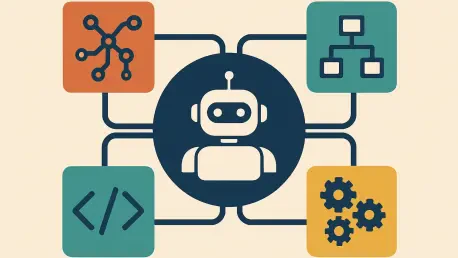In the rapidly evolving world of artificial intelligence, integrating large language models (LLMs) and AI agents with external tools and services has become a critical challenge for developers and architects alike. Whether crafting a nimble application for a small team or designing a sprawling enterprise system that spans multiple platforms, the choice of framework can significantly impact success. Model Context Protocol (MCP), Function Calling, and OpenAPI Tools each offer distinct pathways to connect AI capabilities with actionable resources, yet they cater to vastly different needs and environments. This article delves into the intricacies of these three approaches, shedding light on their unique strengths, limitations, and ideal use cases. From the demand for low-latency responses in constrained apps to the need for robust governance in complex ecosystems, understanding how these frameworks operate is essential. Let’s explore the nuances of MCP, Function Calling, and OpenAPI Tools to guide informed decisions in navigating the intricate landscape of AI-tool integration.
Unpacking the Core Frameworks
The first step in choosing the right tool for AI integration lies in grasping the fundamental nature of MCP, Function Calling, and OpenAPI Tools. MCP stands as a transport-agnostic protocol engineered for cross-platform portability, emphasizing standardized discovery and multi-tool orchestration. This makes it particularly suited for environments where diverse systems and shared integrations are the norm, allowing seamless interaction across various hosts. Its design prioritizes flexibility, enabling dynamic tool exposure that can adapt to different runtimes and servers. Supported by platforms like Microsoft’s Semantic Kernel, MCP is positioned as a forward-thinking solution for developers looking to build reusable, scalable integrations. However, its reliance on robust host policies for security means that careful planning is required to ensure safe implementation across varied contexts. Understanding MCP’s focus on interoperability provides a foundation for assessing its fit in broader, multi-system projects.
Delving deeper into the trio, Function Calling emerges as a vendor-specific feature often associated with major LLM providers like OpenAI and Anthropic. It enables models to select functions based on a JSON Schema, returning arguments for execution within a single application’s runtime. This approach shines in scenarios demanding simplicity and speed, particularly for app-local automations where latency is a critical factor. Its minimal integration overhead allows for rapid setup and tight control loops, making it a preferred choice for smaller, time-sensitive tasks. However, the lack of inherent discovery mechanisms and its ties to specific vendors limit its portability and scalability in larger ecosystems. For projects confined to a single environment with straightforward needs, Function Calling offers an efficient path, but its constraints must be weighed against the potential need for broader compatibility in future expansions or integrations.
Analyzing Design Philosophies and Applications
When comparing MCP, Function Calling, and OpenAPI Tools, their design philosophies reveal stark contrasts that influence their practical applications. MCP is built around the idea of flexibility, supporting reuse across diverse hosts and enabling multi-tool orchestration with ease. This makes it an excellent choice for projects that require shared integrations across agents, IDEs, or backend systems. Its standardized approach to invocation through JSON-RPC sessions ensures consistency, even in complex, multi-runtime setups. As adoption grows with support from platforms like Cursor and hints of deeper Windows integration, MCP is increasingly seen as a solution for long-term scalability. Yet, its complexity in managing security through host policies and session controls might pose challenges for smaller teams lacking the resources for extensive oversight. For those prioritizing cross-platform capabilities, MCP offers a robust framework, provided the necessary governance structures are in place.
On the other hand, Function Calling is tailored for immediacy, focusing on low-latency execution within a confined application scope. Its strength lies in enabling quick, direct interactions between an LLM and predefined functions, ideal for scenarios where response time is paramount. Think of real-time chatbots or automated assistants that need to trigger specific actions without delay—Function Calling fits seamlessly here. However, its vendor-specific nature means that portability across different providers or platforms can be a hurdle, often locking developers into a particular ecosystem. Additionally, the absence of built-in discovery mechanisms means every function must be explicitly defined and managed within the app. While this simplicity aids rapid deployment, it falls short in environments where dynamic tool selection or broader integration is required. Evaluating project timelines and scope is crucial when considering this approach for AI-driven tasks.
OpenAPI Tools, rooted in the mature OpenAPI Specification (OAS 3.1), take a contract-driven stance, excelling in environments where clarity and governance are non-negotiable. By defining HTTP service contracts, these tools enable agentic layers to auto-generate callable functions, making them indispensable in enterprise settings with extensive web services. Their emphasis on security, supported by schemes like OAut## and API keys, ensures compliance with strict standards, a critical factor for large organizations. However, the lack of native support for agentic control loops means an orchestrator or host is often needed to manage interactions, adding a layer of complexity. With widespread adoption through ecosystems like LangChain, OpenAPI Tools are a powerhouse for structured, service-oriented architectures. Assessing the need for robust contracts versus the overhead of additional management is key when opting for this framework in AI integration strategies.
Evaluating Security and Governance Mechanisms
Security remains a paramount concern across all three frameworks, though each tackles it through distinct mechanisms tailored to their design. MCP enforces safety through host policies, per-tool scopes, and user consent protocols, ensuring that interactions remain controlled even in cross-platform scenarios. Indications of potential Windows-level registry controls suggest a strong backing for platform-wide security, which could enhance trust in MCP for sensitive deployments. This structured approach to governance makes it suitable for environments where multiple stakeholders and systems interact, requiring clear boundaries and permissions. Nevertheless, the onus falls on implementers to establish and maintain these policies, which can be resource-intensive for teams without dedicated security expertise. For projects spanning diverse ecosystems, MCP’s security model offers a promising shield, provided the necessary oversight is diligently applied to prevent vulnerabilities.
In contrast, Function Calling adopts a more developer-centric security model, relying heavily on schema validation and allowlists to ensure safe execution of functions. This places significant responsibility on application developers to implement rigorous logging, auditing, and testing practices to mitigate risks. While effective in controlled, app-local settings, this approach lacks the depth of built-in governance seen in other frameworks, making it less ideal for scenarios with heightened compliance demands. Its simplicity aligns with smaller projects where speed trumps extensive security layers, but the potential for oversight gaps must be carefully monitored, especially as applications scale or interact with external data. When latency is the priority, Function Calling can be a viable choice, but only if paired with meticulous validation processes to safeguard against unintended executions or breaches in a contained environment.
OpenAPI Tools embed security directly into their specifications, leveraging defined schemes and gateway enforcement to provide a robust framework for enterprise compliance. Features like OAut## integration and API key authentication ensure that interactions adhere to strict standards, a critical advantage in large-scale, service-heavy architectures. This built-in approach reduces the burden on developers to craft bespoke security measures, though it demands additional orchestration to fully control agentic behaviors. The clarity of contract-based security makes OpenAPI Tools a preferred option for organizations with stringent regulatory needs, ensuring transparency and accountability across HTTP-based services. However, the complexity of integrating an orchestrator can be a barrier for smaller setups lacking the infrastructure to manage it. Balancing governance strength with operational demands is essential when considering this framework for AI-driven integrations.
Navigating the Decision for Optimal Integration
Selecting the most suitable framework among MCP, Function Calling, and OpenAPI Tools requires a clear alignment with specific project objectives and constraints. For initiatives where speed and simplicity are paramount, such as real-time automations within a single application, Function Calling emerges as the optimal choice due to its low-latency design and ease of setup. Its direct execution model suits tasks like triggering quick responses in user-facing apps, provided strict validation and testing are in place to counter its limited portability. However, developers must remain mindful of its vendor-specific constraints, which could hinder adaptability if the project scope expands or shifts to a different provider. When the focus is on immediate, contained functionality with minimal overhead, this approach delivers efficiently, but long-term scalability should be factored into the planning stages to avoid future roadblocks.
For projects demanding cross-runtime portability and dynamic tool discovery across varied ecosystems, MCP stands out as the recommended framework. Its standardized protocol supports shared integrations between agents, IDEs, and backends, making it ideal for collaborative or multi-system environments. The ability to reuse tools across hosts ensures flexibility, a crucial asset for teams anticipating growth or platform shifts. While its security model requires robust host policies, the growing ecosystem support from major platforms signals a reliable foundation for future-proofing integrations. MCP’s strength in orchestration also suits scenarios involving multiple tools interacting dynamically, though it demands a commitment to governance setup. When building for interoperability and scalability across diverse runtimes, MCP provides a strategic edge, especially for forward-looking architectures aiming to bridge varied systems seamlessly.
In enterprise settings with extensive HTTP services and a need for strict governance, OpenAPI Tools offer a compelling solution grounded in clear service contracts. Their reliance on the OpenAPI Specification ensures transparency and compliance, vital for organizations managing complex web-based integrations under regulatory scrutiny. Security features embedded in the framework, coupled with widespread tooling support through platforms like LangChain, make them a powerhouse for structured environments. However, the necessity of an orchestrator to manage agentic interactions introduces additional complexity, which may not suit smaller teams or projects with limited resources. For large-scale deployments where contract clarity and enterprise-grade security are non-negotiable, OpenAPI Tools provide unmatched reliability, provided the infrastructure to support orchestration is in place to maximize their potential.
Reflecting on the detailed exploration of these frameworks, a hybrid strategy often surfaced as a practical path for complex deployments seeking to balance competing priorities. Combining elements of Function Calling for latency-critical tasks, MCP for cross-platform exposure, and OpenAPI Tools for governed service integrations allowed past projects to achieve a tailored fit. This blended approach addressed the trade-offs between speed, flexibility, and compliance, offering a versatile blueprint for success. As integration challenges evolved, the decision to mix and match these tools proved instrumental in meeting diverse needs without sacrificing core objectives. Moving forward, stakeholders are encouraged to assess their specific requirements—be it rapid execution, broad compatibility, or stringent security—and consider hybrid implementations as a way to harness the best of each framework. Evaluating upcoming projects with this adaptable mindset can pave the way for innovative, resilient AI-tool integrations.









